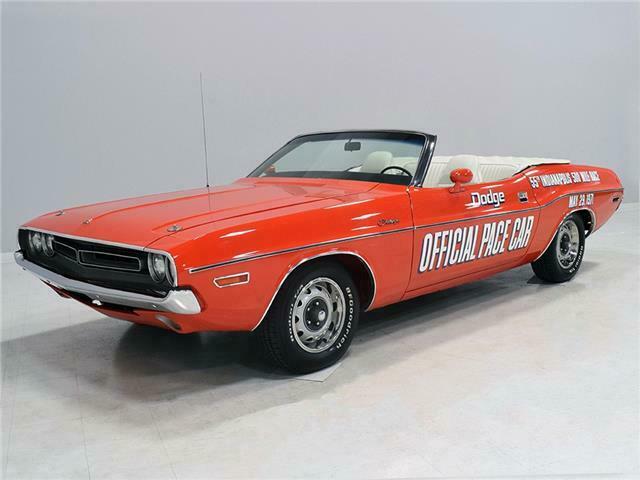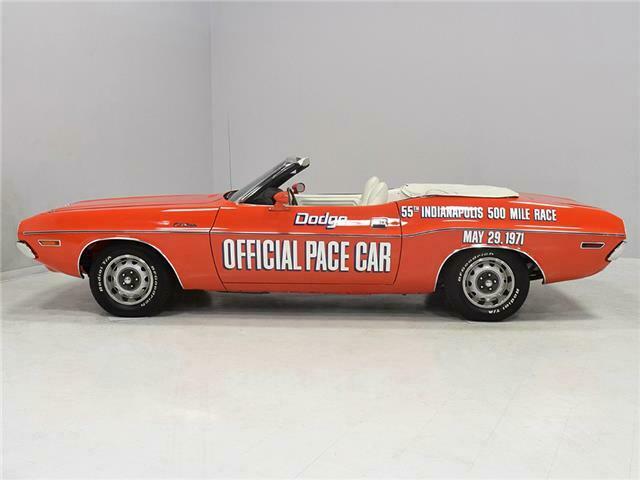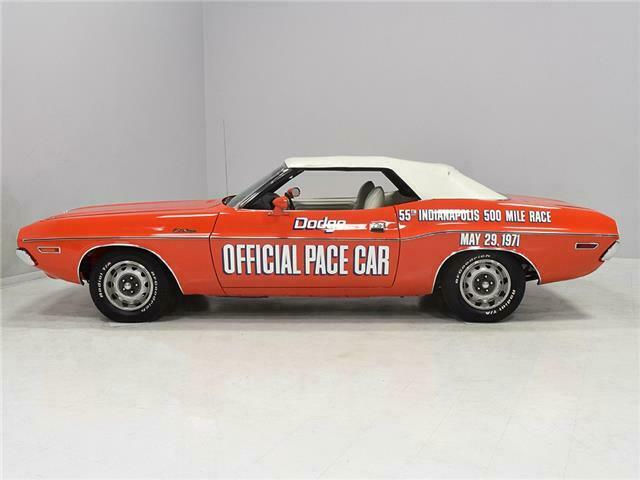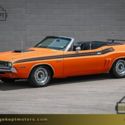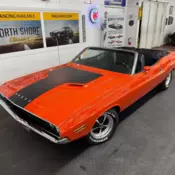1971 Dodge Challenger Pace Car 16363 Miles Hemi Orange 318 cubic inch V8 3-spe
| Make: | Dodge |
| Model: | Challenger Pace Car |
| Type: | -- |
| Trim: | -- |
| Year: | 1971 |
| Mileage: | 16363 |
| VIN: | JH27G1B329577 |
| Color: | Orange |
| Engine: | 318 cubic inch V8 |
| Fuel: | Gasoline |
| Transmission: | Automatic |
| Drive type: | -- |
| Interior color: | White |
| Vehicle Title: | N/A |
| Item location: | Local pick-up only |
1971 Dodge Challenger Pace Car -- Additional Info:
You probably haven’t seen a 1971 Dodge Challenger Indy pace car before, but there are few details you need to know: One, this might be the best one in the known universe, with a spectacular rotisserie restoration by one of the best names in Mopars. Two, 1971 was the first time a manufacturer wasn’t involved in the construction of the official pace cars (insurance rates and gas prices made automakers very skittish about motorsports). And three, 1971 was the LAST... time they let an amateur drive the official pace car at the race. Why? Because Eldon Palmer, owner of Palmer Dodge, driving force behind the Challenger pace cars, and 55th Indianapolis 500 pace car pilot, crashed into the press box when he came off the track a little too hot (there’s a video on YouTube, check it out). Nobody was seriously injured, but it was painfully obvious that putting an amateur in the driver’s seat at those kinds of speeds was a mistake. Eldon Palmer and Palmer Dodge were instrumental in getting the Challenger pace cars built. Palmer rallied local Indianapolis Dodge dealers, who all ordered Hemi Orange Challenger convertibles with white interiors, then added the official pace car graphics. 50 such replicas were sold to enthusiastic race fans, making them a neat footnote in Indianapolis 500 history. They’re quite scarce today, which is why you probably haven’t seen one before, but this gorgeous example has a great history and a spectacular restoration. With only two owners, it has led a very easy life as a treasured toy, and the restoration was managed by the guys at the Final Detail, a well-regarded Mopar shop that knows how these things should look. The car is 100% matching numbers, beautifully detailed, and drives like a new car. It’s just a fantastic car. All the pace cars were Hemi Orange with white interiors, so this ragtop certainly won’t go unnoticed. The finish is show quality with laser-straight original sheetmetal throughout; quarters, fenders, floors, all of it was installed in 1971 by the guys in Hamtramck. Everything was straightened, aligned, and smoothed to a standard far better than new, and then that glowing Hemi Orange paint was sprayed on top. It’s two-stage urethane, so the small amount of metallic that is in Hemi Orange really makes it glow in the sun. They also faithfully replicated the pace car decals in modern vinyl, so they should last forever—the originals were little more than colored tape with some cellophane glued on top and the guys who were there when they were built said they barely lasted through race weekend, never mind the ensuing decades. If you’re going to have a pace car, it may as well look the part and this one is quite attractive indeed. Most of the chrome and stainless was refinished, although you’ll note the original Palmer Dodge dealer sticker is still on the rear bumper, a nice touch. The car is equipped with dual sport mirrors that look great, hood pins, a locking gas cap, and the unusual side rub strip, which wasn’t on all the pace cars but adds a nice bit of contrast. It’s really a great-looking car. The all-white interior is brand new, too, with correct seat covers, new foam so the seats are firm, and reproduction door panels that are just as crisp and bright. Black carpets, dash, and console keep it from being white overload, but even in the sun the light upholstery helps keep you cool. And if that’s not enough, there is functional factory A/C, which still uses good old R12 refrigerant for maximum effect. The gauges are all rebuilt, the woodgrained steering wheel looks fairly convincing, and the familiar “Slap Stik” shifter for the TorqueFlite automatic transmission is easy to manage. The original Music Master AM radio is gone, replaced by a digital AM/FM head unit that fits like the original with both knobs on the same side. You can see the attention to detail throughout: all the courtesy lights work, the window felts are new so it doesn’t have any rattles, and the floor mats are embroidered in orange to match the bodywork. Overhead there’s a new white power convertible top that practically jumps out of the well when you hit the switch, and don’t fret about the wrinkle above the rear window—that’s normal with these tops and goes away after a few minutes in the sun. The trunk is fully finished with a correct reproduction mat, matching spare tire, and complete jack assembly tucked inside the quarter panel. All but three of the pace cars (including the one used on the track) were equipped with a 318 cubic inch V8 with a 2-barrel carburetor, which is how this one is currently configured. This is the car’s original, numbers-matching engine and it was rebuilt to stock specs during the restoration. No, it’s not a horsepower monster, but then again, you saw how much mischief the 383 in the pace car caused. Besides, 225 horsepower makes this relatively lightweight Challenger feel quick around town and it’s just effortless in everything it does. Plenty of torque off the line, almost silent at cruise, and for a muscle car, it’s reasonably thrifty. Nobody’s going to complain about the performance. It’s also quite nicely detailed, with corporate turquoise engine enamel, correct hoses and clamps, and a factory air cleaner assembly up top. Turn the key and it fires easily and idles smoothly, and as I said, it’s a lot of fun to drive. The 3-speed TorqueFlite automatic transmission shifts easily and crisply, and with 3.23 gears out back, it’s a very comfortable cruiser on the highway, where it just loafs along at 75 MPH. The undercarriage is as nicely detailed as the engine bay, with a few minor signs of use but no issues at all. The original floors are in excellent condition and the satin black paint makes a great background for the new Maganaflow stainless exhaust system with X-pipe, so the 318 sounds extremely healthy. Power front disc brakes, new shocks, new lines and hoses, and a fresh gas tank out back make this a car you can drive cross-country with ease and still arrive ready to show. Attractive Rallye wheels look great and carry modern 215/70/14 BFGoodrich T/A radials all around. There’s also a good bit of documentation with this pace car, including magazine and newspaper articles, owner’s manual, and original purchase documentation from Palmer Dodge back in 1971. There’s also some Indy 500 information from the 1971 race and this car is listed in both the Indy Pace Car Registry and the 1971 Dodge Challenger Pace Car Registry, so it’s a known entity. Oh, and there’s also a model version that we’ll admit looks pretty darned authentic. This car is appealing because of its bright pace car look, but the quality of the restoration and the way it feels on the road will make you fall in love. This is one of those exceptional cars that really do stand out from their siblings—don’t buy just because of price, buy quality. Nobody ever regrets doing that. Call today!

